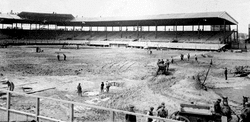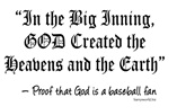
In 1920, the APFL (American Pro Football League) put a team there called the Chicago Tigers. A year later, the Chicago Bears of the NFL started to play their home games in the stadium, where they would stay until 1970. From the years of 1931-1939, a second Chicago NFL team shared Wrigley Field with the Bears. Chicago would eventually add a North American Soccer League team to the mix, with the Chicago Sting playing their home games at Wrigley from 1977-1982, 1984.
The stadium was originally called Weeghman Park, a name that would last through the 1919 season. From 1920-1925, it was called Cubs Park before the stadium was named after owner and chewing gum tycoon Phillip K Wrigley for the 1926 season.
Tracing back the history of this Chicago National League franchise, the team finished ahead of the second place St Louis Browns by 8 games in the regular season. In what was called the World Series though, the Browns managed to tie the Cubs in a series that went 3-3-1. The following season, the Cubs lost the World Series to the Browns 4-2, with St Louis also winning the regular season title by 3 games over Chicago.
The Cubs would not make it back to a Championship game for another 20 years, where they met up with Chicago White Sox of the American League, a series the White Sox would win in 6 games. The Cubs followed that up with their only two World Series Championships, beating the Detroit Tigers and Ty Cobb in both 1907 and 1908. They also appeared in the 1910 World Series, where the Philadelphia Athletics defeated them in 5 games.
The first postseason appearance in the Cubs new stadium was in 1918, where they lost to the Boston Red Sox in 6 games. The Cubs would make it back to the fall classic in 1929 (Athletics), 1932 (Yankees), 1935 (Tigers), 1938 (Yankees) and 1945 (Tigers)- losing all five times. Prior to Weegman Park- Wrigley Field, the Chicago NL franchise was 2-3-1 in World Series play. Since the new stadium was opened, the Cubs have gone 0-6 in World Series play. The Cubs have not been to a World Series since 1945. They did have some close calls, narrowly missing out on the NL East Title to the eventual World Series Champion New York Mets in 1969, losing the NLCS after leading the best of 5 2 games to 0 against the San Diego Padres in 1984 and failing to close out the NLCS after leading the series 3-1 against the Florida Marlins in 2003. They also missed out on a World Series chance in 1989 as they lost the NLCS 4-1 to the San Francisco Giants.
The Cubs are off to a slow start in 2014 but hopes are the team will look a little stronger because of their good farm system. Players like SS Javier Baez, Jorge Soler and eventually 3B Kris Bryant should become the new heart of the Cubs order as the team should become tougher over the next couple seasons. The Cubs fans deserve what all other cities that had baseball teams in 1908 have seen since, a World Series Championship. While the Red Sox drought was ended in 2004 after 86 seasons, the Cubs drought is entering its 106th consecutive year without a title and 69th without a NL Pennant.
What could make a Cubs fan feel a little better is the fact that there are cities that have not won a World Series- ever. I know Tampa Bay (1998) and Colorado (1993) have not been around long, but the cities of Seattle (1977), San Diego (1969), Montreal (1969-2004) and Houston (1962) have never seen a World Series as well. The Brewers have never won one since they became an expansion team in 1969 (Seattle Pilots for one season) and the Kansas City Athletics, who existed from 1955-1967, never won a World Series.
What has always been fascinating about the history of Wrigley Field is the fact that it has always been known as playing the most day games in all of MLB. In fact, it was not until 1988 where the Chicago Cubs played a night home game at Wrigley. The stadium will always be known for the ivy which covers the outside of the outfield walls. The manual scoreboard is historic as the Cubs are the only MLB franchise without any sort of jumbo tron, something that may possibly chance over the near or distant future. When the stadium opened up for Federal League baseball in 1914, the capacity for the stadium was 14,000. It currently seats 41,072 as of the start of the 2014 season, 100 years later.

 RSS Feed
RSS Feed
